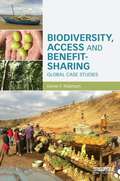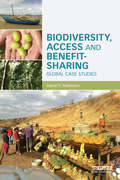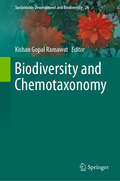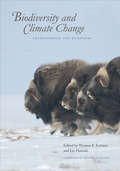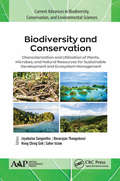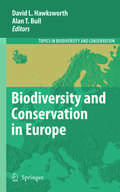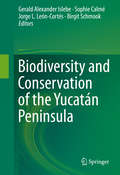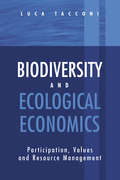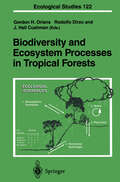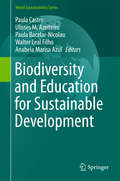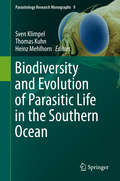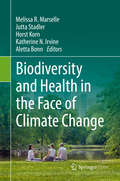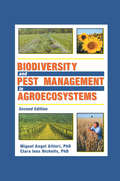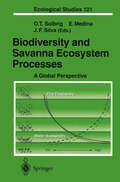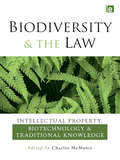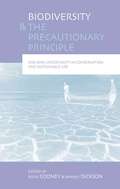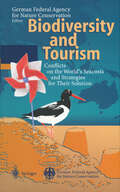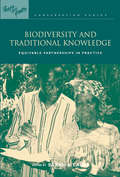- Table View
- List View
Biodiversity, Access and Benefit-sharing: Global Case Studies (PDF)
by Daniel F. RobinsonThe Nagoya Protocol to the Convention on Biological Diversity (CBD) is rapidly receiving signatures and ratifications. Many countries are preparing to implement the protocol through national research permit systems and/or biodiversity laws. Yet there is still considerable confusion about how to implement the Protocol, regarding access and benefit-sharing (ABS) procedures, and minimal experience in many countries. This book seeks to remedy this gap in understanding by analysing a number of ABS case studies in light of the Nagoya Protocol. The case studies are wide-ranging, with examples of plants and micro organisms for medicinal, cosmetic, biotech and food products, from or for development in, Australia, North Africa, Madagascar, Thailand, the United States, Switzerland, Panama and the Pacific. These will encourage countries to develop national systems which maximise their benefits (both monetary and non-monetary) towards conservation and support for local communities that hold traditional knowledge. In addition, the author analyses new expectations raised by the Nagoya Protocol, such as the encouragement of the development of community protocols by indigenous and local communities. As a result, stakeholders and policy-makers will be able to learn the steps involved in establishing ABS agreements, issues that arise between stakeholders, and the types of benefits that might be realistic.
Biodiversity, Access and Benefit-sharing: Global Case Studies
by Daniel F. RobinsonThe Nagoya Protocol to the Convention on Biological Diversity (CBD) is rapidly receiving signatures and ratifications. Many countries are preparing to implement the protocol through national research permit systems and/or biodiversity laws. Yet there is still considerable confusion about how to implement the Protocol, regarding access and benefit-sharing (ABS) procedures, and minimal experience in many countries. This book seeks to remedy this gap in understanding by analysing a number of ABS case studies in light of the Nagoya Protocol. The case studies are wide-ranging, with examples of plants and micro organisms for medicinal, cosmetic, biotech and food products, from or for development in, Australia, North Africa, Madagascar, Thailand, the United States, Switzerland, Panama and the Pacific. These will encourage countries to develop national systems which maximise their benefits (both monetary and non-monetary) towards conservation and support for local communities that hold traditional knowledge. In addition, the author analyses new expectations raised by the Nagoya Protocol, such as the encouragement of the development of community protocols by indigenous and local communities. As a result, stakeholders and policy-makers will be able to learn the steps involved in establishing ABS agreements, issues that arise between stakeholders, and the types of benefits that might be realistic.
Biodiversity, Access and Benefit-Sharing: Global Case Studies
by Daniel F. RobinsonThe Nagoya Protocol to the Convention on Biological Diversity (CBD) is rapidly receiving signatures and ratifications. Many countries are preparing to implement the protocol through national research permit systems and/or biodiversity laws. Yet there is still considerable confusion about how to implement the Protocol, regarding access and benefit-sharing (ABS) procedures, and minimal experience in many countries. This book seeks to remedy this gap in understanding by analysing a number of ABS case studies in light of the Nagoya Protocol. The case studies are wide-ranging, with examples of plants for medicinal, cosmetic, biotech and food products from or for development in Australia, North Africa, Madagascar, Switzerland, Thailand, USA and Oceania. These will encourage countries to develop national systems which maximise their benefits (both monetary and non-monetary) towards conservation and support for local communities that hold traditional knowledge. In addition, the author analyses new expectations raised by the Nagoya Protocol, such as the encouragement of the development of community protocols by indigenous and local communities. As a result, stakeholders and policy-makers will be able to learn the steps involved in establishing ABS agreements, issues that arise between stakeholders, and the types of benefits that might be realistic.
Biodiversity, Access and Benefit-Sharing: Global Case Studies
by Daniel F. RobinsonThe Nagoya Protocol to the Convention on Biological Diversity (CBD) is rapidly receiving signatures and ratifications. Many countries are preparing to implement the protocol through national research permit systems and/or biodiversity laws. Yet there is still considerable confusion about how to implement the Protocol, regarding access and benefit-sharing (ABS) procedures, and minimal experience in many countries. This book seeks to remedy this gap in understanding by analysing a number of ABS case studies in light of the Nagoya Protocol. The case studies are wide-ranging, with examples of plants for medicinal, cosmetic, biotech and food products from or for development in Australia, North Africa, Madagascar, Switzerland, Thailand, USA and Oceania. These will encourage countries to develop national systems which maximise their benefits (both monetary and non-monetary) towards conservation and support for local communities that hold traditional knowledge. In addition, the author analyses new expectations raised by the Nagoya Protocol, such as the encouragement of the development of community protocols by indigenous and local communities. As a result, stakeholders and policy-makers will be able to learn the steps involved in establishing ABS agreements, issues that arise between stakeholders, and the types of benefits that might be realistic.
Biodiversity and Chemotaxonomy (Sustainable Development and Biodiversity #24)
by Kishan Gopal RamawatPlant classifications are based on morphological characters and it is difficult, particularly in small plants and grasses, to identify these below generic level on the basis of these characters using a dissecting microscope. Plant species have intra- and inter-specific variation in secondary metabolites which can be utilized as marker compounds for identification and classification of plants. Secondary metabolites are produced as a result of primary metabolism and the production of these compounds not only involves several genes but also it is an energy dependent process. Hence these products cannot be considered as insignificant for the plant and the environment. Modern tools of molecular biology and secondary metabolites present in them can definitively decide about classification of plants. Absence of correct identification of plant is associated to many problems of resource utilization. Due to wide availability of these tools, interest has revived in systematics and correct classification of plants based on these parameters for their sustainable utilization and resource management. The purpose of this book is to assess the potential of phytochemical and molecular tools in the systematic and classification of plants. The topics covered include species concept, barcoding and phylogenetic analysis, chemotaxonomy use of polyketides, carotenes, cuticular wax, volatile oils, biodiversity of corals, metazoans, Ruta and Echinocereus. It provides comprehensive and broad subject-based reviews, useful for students, teachers, researchers, and all others interested in the field. The field has been kept wide and general to accommodate the wide-ranging topics. This book will be useful to agriculturists, chemists, botanists, industrialists, and those involved in planning of crop plants.
Biodiversity and Climate Change: Transforming the Biosphere
by Thomas E. Lovejoy Lee Hannah Edward O. WilsonAn essential, up-to-date look at the critical interactions between biological diversity and climate change that will serve as an immediate call to action The physical and biological impacts of climate change are dramatic and broad†‘ranging. People who care about the planet and manage natural resources urgently need a synthesis of our rapidly growing understanding of these issues. In this all†‘new sequel to the 2005 volume Climate Change and Biodiversity, leading experts in the field summarize observed changes, assess what the future holds, and offer suggested responses. From extinction risk to ocean acidification, from the future of the Amazon to changes in ecosystem services, and from geoengineering to the power of ecosystem restoration, this book captures the sweep of climate change transformation of the biosphere.
Biodiversity and Conservation: Characterization and Utilization of Plants, Microbes and Natural Resources for Sustainable Development and Ecosystem Management (Current Research in Ethnomusicology: Outstanding Dissertations)
by Jeyabalan Sangeetha Devarajan Thangadurai Hong Ching Goh Saher IslamThis volume provides an enlightening and pragmatic approach to preserving biological diversity by gathering a wide range of peer-reviewed scientific content from biodiversity researchers and conservators from around the world. It brings comprehensive knowledge and information on the present status of conservation of biological diversity including floral, faunal, and microbial diversity. A detailed account of recent trends in conservation and applications under changing climate conditions, focusing mainly on agriculturally and industrially important microbes and their sustainable utilization, is presented as well. Over the past five decades, extensive research work has been done on many aspects of biodiversity conservation and sustainable utilization of biological resources. This book examines this crucial issue. Chapters discuss biodiversity concepts, benefits, and values for economic and sustainable development; explores applications and strategies for biodiversity preservation; and considers the role of biodiversity conservation in public awareness services and cultural significance. The volume also examines the process of evolution and the future of biodiversity in conjunction with climate change factors, with special reference to infectious diseases.
Biodiversity and Conservation: Characterization and Utilization of Plants, Microbes and Natural Resources for Sustainable Development and Ecosystem Management (Current Research in Ethnomusicology: Outstanding Dissertations)
by Jeyabalan Sangeetha Devarajan Thangadurai Hong Ching Goh Saher Islam MPhilThis volume provides an enlightening and pragmatic approach to preserving biological diversity by gathering a wide range of peer-reviewed scientific content from biodiversity researchers and conservators from around the world. It brings comprehensive knowledge and information on the present status of conservation of biological diversity including floral, faunal, and microbial diversity. A detailed account of recent trends in conservation and applications under changing climate conditions, focusing mainly on agriculturally and industrially important microbes and their sustainable utilization, is presented as well. Over the past five decades, extensive research work has been done on many aspects of biodiversity conservation and sustainable utilization of biological resources. This book examines this crucial issue. Chapters discuss biodiversity concepts, benefits, and values for economic and sustainable development; explores applications and strategies for biodiversity preservation; and considers the role of biodiversity conservation in public awareness services and cultural significance. The volume also examines the process of evolution and the future of biodiversity in conjunction with climate change factors, with special reference to infectious diseases.
Biodiversity and Conservation in Europe (Topics in Biodiversity and Conservation #7)
by David L. Hawksworth Alan T. BullThis book brings together a selection of original studies that address biodiversity and conservation in Europe. The contributions are drawn from a wide range of countries and discuss diverse organism and habitat types. They collectively provide a snap-shot of the sorts of studies and actions being taken in Europe to address issues in biodiversity and conservation – topical examples that make the volume especially valuable for use in conservation biology courses.
Biodiversity and Conservation of the Yucatán Peninsula
by Gerald Alexander Islebe Sophie Calmé Jorge L. León-Cortés Birgit SchmookThis book provides information relevant for the conservation of biodiversity and the sound management of the coastal and forest ecosystems of the Yucatan Peninsula in the face of global change. Various aspects of the biodiversity of the Yucatan Peninsula are analyzed in an integrative manner, including phenological, ecophysiological, ecological and conservation aspects of plants and animals and their relationships with humans in coastal and forest ecosystems.
Biodiversity and Ecological Economics: Participatory Approaches to Resource Management
by Luca TacconiIt is vital that we adopt interdisciplinary approaches such as ecological economics to gain an understanding of the values that determine human interaction with, and use and abuse of, the environment. This book is a model of applied ecological economics. It presents an accessible introduction to the subject while at the same time broadening its theoretical basis by introducing a post-positivist, participatory method. The theoretical framework is applied to case studies in biodiversity conservation, drawn from around the world and a range of different ecosystems. The book is a suitable textbook for students of ecological economics and an ideal introduction for scientists and environmentalists needing to understand the role of economics in ecology and conservation.
Biodiversity and Ecological Economics: Participatory Approaches to Resource Management
by Luca TacconiIt is vital that we adopt interdisciplinary approaches such as ecological economics to gain an understanding of the values that determine human interaction with, and use and abuse of, the environment. This book is a model of applied ecological economics. It presents an accessible introduction to the subject while at the same time broadening its theoretical basis by introducing a post-positivist, participatory method. The theoretical framework is applied to case studies in biodiversity conservation, drawn from around the world and a range of different ecosystems. The book is a suitable textbook for students of ecological economics and an ideal introduction for scientists and environmentalists needing to understand the role of economics in ecology and conservation.
Biodiversity and Ecosystem Processes in Tropical Forests (Ecological Studies #122)
by Gordon H. Orians Rodolfo Dirzo J. Hall CushmanAlthough biologists have directed much attention to estimating the extent and causes of species losses, the consequences for ecosystem functioning have been little studied. This book examines the impact of biodiversity on ecosystem processes in tropical forests - one of the most species-rich and at the same time most endangered ecosystems on earth. It covers the relationships between biodiversity and primary production, secondary production, biogeochemical cycles, soil processes, plant life forms, responses to disturbance, and resistance to invasion. The analyses focus on the key ecological interfaces where the loss of keystone species is most likely to influence the rate and stability of ecosystem processes.
Biodiversity and Education for Sustainable Development (World Sustainability Series)
by Paula Castro Ulisses M. Azeiteiro Paula Bacelar-Nicolau Walter Leal Filho Anabela Marisa AzulThis book gathers interdisciplinary reflections from researchers, educators, and other experts on the subject of biodiversity closer to education and learning. The book also highlights its role as an added value to strategic principles for healthy ecosystems and sustainable human development. It promotes critical thinking and foster practices and attitudes for Education for Sustainable Development reconciling education with principles of human behaviour and nature. Readers especially find this book a timely resource in light of the Strategic Plan for Biodiversity 2011–2020, the Aichi Targets, and the new EU biodiversity strategy “Our life insurance, our natural capital: an EU biodiversity strategy to 2020”. Along with the challenge of ecosystems and public health, biodiversity conservation is essential for humanity’s continued security and sustainability, as it touches on all aspects of people’s lives.
Biodiversity and Evolution of Parasitic Life in the Southern Ocean (Parasitology Research Monographs #9)
by Sven Klimpel Thomas Kuhn Heinz MehlhornThe Southern Oceans including Antarctic regions are peculiar and very sensitive water biotopes, where animal life and species interrelations are only poorly investigated. Especially the influence of parasites on their host species needs intensive consideration in times of global warming and worldwide pollution. Both factors may influence the finely balanced interrelationships between parasites and endangered hosts especially in specialized regions such as Antarctica. Before this background the present book offers a broad spectrum of important parasite-host interrelations in times of ecosystem changes written by experienced and renown international specialists.
Biodiversity and Health in the Face of Climate Change
by Melissa R. Marselle Jutta Stadler Horst Korn Katherine N. Irvine Aletta BonnThis open access book identifies and discusses biodiversity’s contribution to physical, mental and spiritual health and wellbeing. Furthermore, the book identifies the implications of this relationship for nature conservation, public health, landscape architecture and urban planning – and considers the opportunities of nature-based solutions for climate change adaptation. This transdisciplinary book will attract a wide audience interested in biodiversity, ecology, resource management, public health, psychology, urban planning, and landscape architecture. The emphasis is on multiple human health benefits from biodiversity - in particular with respect to the increasing challenge of climate change. This makes the book unique to other books that focus either on biodiversity and physical health or natural environments and mental wellbeing. The book is written as a definitive ‘go-to’ book for those who are new to the field of biodiversity and health.
Biodiversity and Pest Management in Agroecosystems
by Miguel Altieri Clara NichollsExplore the latest research on biological control! Completely updated for 2004, this new edition examines methods for making agricultural systems less susceptible to insect pests. Containing new findings and reports of strategies, Biodiversity and Pest Management in Agroecosystems, Second Edition will show you how pests can be managed by enhancing beneficial biodiversity using agroecological diversification methods. Biodiversity and Pest Management in Agroecosystems, Second Edition provides you with an essential overview of the role of biodiversity in agriculture and then gets specific, with new and updated information on: the agroecology of pest management plant diversity and pest outbreaks within agroecosystems diversification strategies for pest management how sustainable farming systems are designed You'll also explore: the role of plant diversity on the biology of beneficial insects insect regulation in diverse agroecosystems manipulation of plant diversity in agroecosystems ecological and socioeconomic implications The fact is, many modern agroecosystems are unstable as a consequence of constant human intervention in crop systems which ignore ecological principles. With case studies on a variety of crops and pests, Biodiversity and Pest Management in Agroecosystems, Second Edition explores entomological aspects of agriculture and analyzes the ecological basis for the maintenance of biodiversity. It will familiarize you with the theory and practice of enhancing biological pest control in agricultural systems by managing vegetational diversity via multiple cropping, cover cropping, rotations, and other spatial and temporal designs. With studies on intercropping, cover cropping, weed management, and crop-field border vegetation manipulation, this book covers the effects of these diverse systems on pest population density and the mechanisms underlying pest reduction in polycultures. Make it a part of your reference/teaching collection today!
Biodiversity and Pest Management in Agroecosystems
by Miguel Altieri Clara NichollsExplore the latest research on biological control! Completely updated for 2004, this new edition examines methods for making agricultural systems less susceptible to insect pests. Containing new findings and reports of strategies, Biodiversity and Pest Management in Agroecosystems, Second Edition will show you how pests can be managed by enhancing beneficial biodiversity using agroecological diversification methods. Biodiversity and Pest Management in Agroecosystems, Second Edition provides you with an essential overview of the role of biodiversity in agriculture and then gets specific, with new and updated information on: the agroecology of pest management plant diversity and pest outbreaks within agroecosystems diversification strategies for pest management how sustainable farming systems are designed You'll also explore: the role of plant diversity on the biology of beneficial insects insect regulation in diverse agroecosystems manipulation of plant diversity in agroecosystems ecological and socioeconomic implications The fact is, many modern agroecosystems are unstable as a consequence of constant human intervention in crop systems which ignore ecological principles. With case studies on a variety of crops and pests, Biodiversity and Pest Management in Agroecosystems, Second Edition explores entomological aspects of agriculture and analyzes the ecological basis for the maintenance of biodiversity. It will familiarize you with the theory and practice of enhancing biological pest control in agricultural systems by managing vegetational diversity via multiple cropping, cover cropping, rotations, and other spatial and temporal designs. With studies on intercropping, cover cropping, weed management, and crop-field border vegetation manipulation, this book covers the effects of these diverse systems on pest population density and the mechanisms underlying pest reduction in polycultures. Make it a part of your reference/teaching collection today!
Biodiversity and Savanna Ecosystem Processes: A Global Perspective (Ecological Studies #121)
by Otto T. Solbrig Ernesto Medina Juan F. SilvaSavannas are the most widespread ecosystem in the tropics and as such are subjected to great human pressure that may result in massive soil degradation. The book addresses the role of species in the function of savanna ecosystems. It is shown that savannas are enormously diverse and that four factors determine the function of savanna ecosystems: Plant Available Moisture; Plant Available Nutrients; Fire; Herbivores.
Biodiversity and the Law: "Intellectual Property, Biotechnology and Traditional Knowledge"
by Charles R. McManisHow do we promote global economic development, while simultaneously preserving local biological and cultural diversity? This authoritative volume, written by leading legal experts and biological and social scientists from around the world, aims to address this question in all of its complexity. The first part of the book focuses on biodiversity and examines what we are losing, why and what is to be done. The second part addresses biotechnology and looks at whether it is part of the solution or part of the problem, or perhaps both. The third section examines traditional knowledge, explains what it is and how, if at all, it should be protected. The fourth and final part looks at ethnobotany and bioprospecting and offers practical lessons from the vast and diverse experiences of the contributors.
Biodiversity and the Law: "Intellectual Property, Biotechnology and Traditional Knowledge"
by Charles R. McManisHow do we promote global economic development, while simultaneously preserving local biological and cultural diversity? This authoritative volume, written by leading legal experts and biological and social scientists from around the world, aims to address this question in all of its complexity. The first part of the book focuses on biodiversity and examines what we are losing, why and what is to be done. The second part addresses biotechnology and looks at whether it is part of the solution or part of the problem, or perhaps both. The third section examines traditional knowledge, explains what it is and how, if at all, it should be protected. The fourth and final part looks at ethnobotany and bioprospecting and offers practical lessons from the vast and diverse experiences of the contributors.
Biodiversity and the Precautionary Principle: Risk, Uncertainty and Practice in Conservation and Sustainable Use
by Rosie Cooney Barney DicksonGreat uncertainty typically surrounds decisions and management actions in the conservation of biodiversity and natural resource management, and yet there are risks of serious and irreversible harm for both biodiversity and the humans that rely on it. The precautionary principle arguably underlies all international conservation efforts and promotes acting to avoid serious or irreversible environmental harm, despite lack of scientific certainty as to the likelihood, magnitude or cause of harm. This book is the first to examine the application of the precautionary principle to biodiversity conservation and natural resource management, incorporating perspectives from scientists, economists, lawyers and practitioners from both developing and developed countries. It analyses the application and impacts of the principle in many areas including forestry, invasive alien species, wildlife trade, protected areas and fisheries, in a range of national and international contexts. Particular attention is drawn to issues of equity, livelihoods, science and politics, and the book provides guidelines for applying the precautionary principle to biodiversity conservation and natural resource management.
Biodiversity and the Precautionary Principle: Risk, Uncertainty and Practice in Conservation and Sustainable Use
by Rosie Cooney Barney DicksonGreat uncertainty typically surrounds decisions and management actions in the conservation of biodiversity and natural resource management, and yet there are risks of serious and irreversible harm for both biodiversity and the humans that rely on it. The precautionary principle arguably underlies all international conservation efforts and promotes acting to avoid serious or irreversible environmental harm, despite lack of scientific certainty as to the likelihood, magnitude or cause of harm. This book is the first to examine the application of the precautionary principle to biodiversity conservation and natural resource management, incorporating perspectives from scientists, economists, lawyers and practitioners from both developing and developed countries. It analyses the application and impacts of the principle in many areas including forestry, invasive alien species, wildlife trade, protected areas and fisheries, in a range of national and international contexts. Particular attention is drawn to issues of equity, livelihoods, science and politics, and the book provides guidelines for applying the precautionary principle to biodiversity conservation and natural resource management.
Biodiversity and Tourism: Conflicts on the World’s Seacoasts and Strategies for Their Solution
by F. DahmsIt is in the best interest of all concerned that tourism become sustainable and environmentally compatible. This need for "sustainable development" is and more by the responsible parties. Moreover, in the being recognised more search for solution strategies the realisation is gaining ground that tourism must be viewed as a worldwide phenomenon whose development must be co-ordinated in a co-operative effort spanning regions and continents. That the preservation of biological diversity also requires global co operation has been confirmed by over 170 countries which have already acceded to the "Convention on Biological Diversity". It is thus an important task to provide the foundations for joint action. Germany, one of the largest source countries of international tourism, must feel particularly obligated in this regard. The report published here is the result of a research project com missioned by the German Federal Agency for Nature Conservation. The study pursued and examined the thesis that the Convention on Biological Diversity be used as a central instrument for arriving at international principles and regulations for combining nature conservation and tourism which could lead to a sustainable development of tourism. To further the discussion, the authors brought the study to a logical conclusion by working out a proposal for a "tourism protocol" additional to the existing Convention on Biodiversity. Such a protocol additional to the Convention would entail the stipulation of internationally binding implementation and regulations for achieving sustainable tourism.
Biodiversity and Traditional Knowledge: Equitable Partnerships in Practice
by Sarah A LairdBiodiversity research and prospecting are long-standing activities taking place in a new legal and ethical environment. Following entry into force of the Convention on Biological Diversity in 1993, and other recent policy developments, expectations and obligations for research and prospecting partnerships have changed. However, to date there are few guides to integrating these concepts with practice. This book offers practical guidance on how to arrive at equitable biodiversity research and prospecting partnerships. Drawing on experience and lessons learned from around the world, it provides case studies, analysis and recommendations in a range of areas that together form a new framework for creating equity in these partnerships. They include researcher codes of ethics, institutional policies, community research agreements, the design of more effective commercial partnerships and biodiversity prospecting contracts, the drafting and implementation of national 'access and benefit-sharing' laws, and institutional tools for the distribution of financial benefits. As part of the People and Plants initiative to enhance the role of communities in efforts to conserve biodiversity and use natural resources sustainably, Biodiversity and Traditional Knowledge will be invaluable to students, researchers and local communities, academic institutions, international agencies, government bodies and companies involved in biodiversity research, prospecting and conservation.
